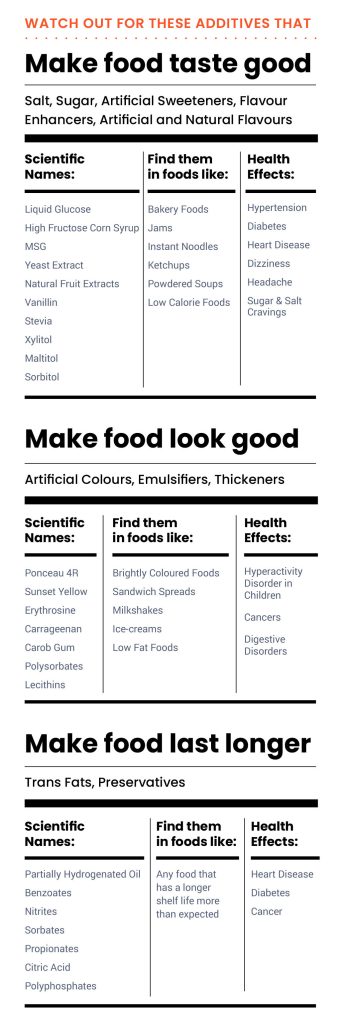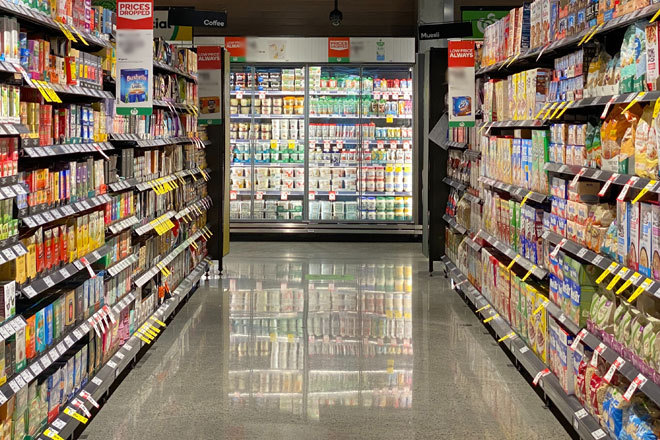Ponceau 4R, Sodium carboxymethyl cellulose, Butylated hydroxyanisole, Polydimethylsiloxane, Propyl gallate, Sunset Yellow, liquid glucose, high fructose corn syrup, microcrystalline cellulose…..and so on.
If you happen to be a label reader, these names will ring a bell. While they may sound like labels on laboratory chemicals, they are in fact names found on food boxes and bottles in the supermarket’s processed foods aisle. The uncomfortable truth: However hard we try to keep man-made food additives away, they more often than not make their way into the food we eat alongside natural ingredients like wheat flour, chilli powder, turmeric powder and salt.
So, what are food additives?
Simply put, food additives are substances added during processing to make food products taste, look or store better. Some food additives like trans fats make food look better and taste better. In contrast, others like colourings will only make foods look better. The addition of these is regulated by the Food Safety and Standards Authority of India (FSSAI) in India; however, it is essential to know what’s in the food we eat and how it impacts our bodies.
Food additives that make food taste good.
A tiny fraction of the food additives that help food taste better are familiar kitchen staples like sugar, salt and vinegar. However, a more significant fraction are substances that have been tweaked or refined from natural sources. For example, chemists have played around with the structure of cane sugar and have produced more potent or portable sweeteners such as high fructose corn syrup and liquid glucose. These contribute calories. So to make foods low-calorie, artificial sweeteners or sugar substitutes such as aspartame, saccharin and sucralose were created. Naturally occurring sugar substitutes such as stevia or sugar alcohols (xylitol, maltitol, sorbitol) have also made their way into low-calorie foods.
Additives such as MSG or yeast extract are added to savoury foods to help kick up the umami flavour profile a few notches. Artificial flavours or naturally derived flavours are also added to oomph up the taste of foods.
So how do these affect your health? The link between high sugar foods, obesity and metabolic syndrome is known by everyone. Yet, we find it painfully hard to control sugar cravings. Similarly, salt cravings result in an almost Pavlovian response to just the thought of instant noodles or pani puri.
One of the reasons for this is we just do not realise how addictive sugar and salt can be. These intensely flavoured foods trigger the brain, releasing serotonin or dopamine that makes us feel happy or tells us to reward ourselves. Over time, the body’s tolerance builds up, and we need more to reward ourselves. This also happens with foods that have artificial sweeteners… as long as the brain perceives sweetness, it needs more of it. The more sodium or intense savoury notes a food promises, the more it is craved. Most parents know this to be true – their kid eats a snack for the ketchup that accompanies it.
Apart from hypertension and high blood sugar associated with excess salt and sugar, some individuals sensitive to glutamate can end up with headaches and dizziness with MSG and yeast extract containing foods.
Food additives that make food look good
This category includes artificial or natural colours that intensify fruit jams, emulsifiers that hold together milkshakes or vegetarian mayo, and thickeners that give sandwich dressing the smoothness and body. Brilliant Blue, Red 3 or erythrosine, carrageenan, carob gum, polysorbates and lecithins are some of the names of additives that help make food look good.
Children are particularly vulnerable to the effect of food colourings as they are the largest consumers of highly coloured foods like hard candy, cupcakes and sweets. Some colours have been shown to promote hyperactivity in sensitive children, while others such as Red 3 has indicated an increased risk of thyroid tumours in animal studies. It is generally accepted that more studies are needed as some find them safe while others suggest a negative health impact.
Thickeners and emulsifiers are generally considered safe. Depending on your perspective and health goals, the only drawback or advantage is a feeling of fullness or satiety. However, some reports, especially of carrageenan, have shown to impact gut health and cause digestive issues.
Food additives that make food last longer.
The keyword here is preservatives. Benzoates, nitrites, sorbates, propionates, citric acid, polyphosphates, and the list goes on. They work by reducing microorganism contamination and preventing food spoilage. This category has the largest footprint in terms of processed food. Some of these are considered safe, while others, such as sodium nitrite, which is found in meat products (increases colour as well), have been linked to cancers, especially when consumed in large amounts. Butylated hydroxytoluene (BHT), another preservative found in chewing gum, meat, baked goods and butter is banned in some countries as it is thought to be a potential carcinogen.
Trans fats which are structurally altered solid fats like margarine and dalda, help make foods taste good and last longer. These can be found on the food labels as “partially hydrogenated oils” and are the worst of the food additives as they cause heart disease, diabetes and cancer. To regulate their damaging effect on health, FSSAI has limited the amounts of trans fats in packaged foods to less than 2% by this year.
The Bottom Line
Should you be consuming foods that contain food additives? Ideally, not. However, it isn’t easy to stay clear of processed foods in this day and age. There are so many different categories of additives besides those we’ve discussed above such as anti-caking agents, bulking agents, gelling agents, anti-oxidants, glazing agents and so on. Processed foods have also gotten a foothold in our daily diet. A recent study concluded that Indian consumers (both rural and urban) consume an average of between 8 to 10% of daily calories from processed foods. It tips at 30% in certain sections of the population in urban areas.
Given that regulatory agencies are okay with food additives within a specific permissible limit, it’s best to make sure that you only eat foods packed with additives in moderate amounts if unavoidable. It is also important to keep an eye out for new studies that shed light on new findings. For example, cellulose gum or CMC, an emulsifier and thickener added to foods such as milk, ice-creams and some baked goods, is thought to just pass through the gut before making its way out of the body. However, a recent study found that in a short span of 2 weeks, although CMC did not cause any disease or disease symptoms, it did cause changes in the gut which was reminiscent of changes that occur in the gut of individuals with type 2 diabetes and inflammatory bowel disease.
The “Health Star” is here to help
The FSSAI plans to mark food products with a “health star” depending on the amount of salt, sugar and fats it contains. So you will soon be able to take better control, quickly differentiating between the healthy and not-so-healthy food.
Taking care starts with being aware
Escaping food additives is easier said than done. But staying alert and aware can work wonders. Read food labels, keep an eye out for new research on additives, and avoid processed foods as much as you can. When it comes to your diet, always think fresh.

*This table is just the tip of the food additives iceberg. A more comprehensive list and its permissible amounts in different foods can be found on the FSSAI website. Accessed on 2nd March 2022
Written by:
Dr. Sripriya Venkiteswaran (Ph D Nutritional Sciences)
Content Consultant: CICN
References:
Sharma, M., Kishore, A., Roy, D. et al. A comparison of the Indian diet with the EAT-Lancet reference diet. BMC Public Health 20, 812 (2020). A comparison of the Indian diet with the EAT-Lancet reference diet – BMC Public Health
12 Common Food Additives — Should You Avoid Them? Accessed on 2nd March 2022
3 Reasons You Crave Sweet or Salty Foods Accessed on 2nd March 2022
Common food additives and chemicals harmful to children – Harvard Health Accessed on 2nd March 2022
Widely used food additive alters the intestinal environment of healthy persons, research shows Accessed on 2nd March 2022





